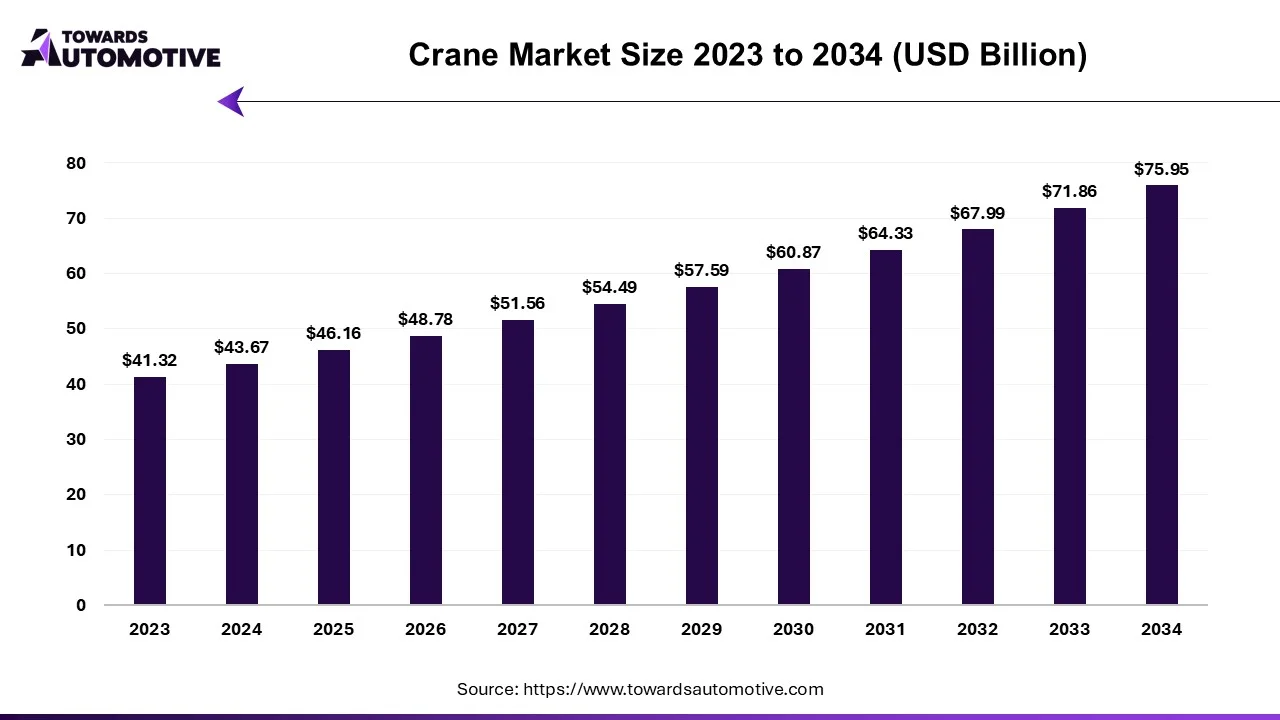The global crane market is experiencing robust growth, fueled largely by the construction industry. Valued at USD 43.67 billion in 2024, the market is projected to reach USD 75.95 billion by 2034, expanding at a compound annual growth rate (CAGR) of 5.69% over the next decade. This growth is driven by rapid urbanization, population expansion, and an increase in infrastructure investments. Cranes have become indispensable in the construction sector, playing a crucial role in tasks such as lifting, moving, and placing heavy materials with precision and efficiency. The surge in large-scale construction projects—ranging from residential complexes to commercial buildings and industrial facilities—has further accelerated the demand for cranes to meet tight timelines and ensure smooth operations on job sites.

Get All the Details on Our Solutions – Brochure Download @ https://www.towardsautomotive.com/download-brochure/1092
Growth in Infrastructure Projects
The global rise in infrastructure projects is one of the primary factors driving crane market growth. Governments around the world, particularly in emerging economies, are investing heavily in infrastructure to support the demands of urbanization. These large-scale initiatives, including highways, railways, bridges, and airports, require cranes to manage complex lifting tasks. The increasing need for cranes in these infrastructure projects creates substantial market opportunities, with manufacturers racing to meet the rising demand for advanced equipment capable of handling larger, more demanding projects.
Demand for Specialized Cranes
As construction projects evolve and become more diverse, so too does the demand for specialized cranes. Tower cranes, in particular, are in high demand for high-rise buildings and dense urban areas where vertical lifting capabilities are essential. Mobile and crawler cranes are favored for their versatility and ability to operate efficiently on a variety of infrastructure and industrial sites. Furthermore, the rise of prefabrication and modular construction has sparked a need for cranes that can handle large prefabricated components. This shift is changing how cranes are used in the construction industry, driving innovation and pushing manufacturers to develop more efficient, adaptable cranes that can meet the needs of modern construction practices.
Technological Advancements in Crane Operations
Technological advancements are revolutionizing crane operations within the construction sector, contributing to both efficiency and safety. Automation, IoT-enabled systems, and real-time data monitoring are transforming the way cranes are operated, reducing downtime, improving safety, and enhancing operational efficiency. These innovations allow crane operators to remotely monitor equipment performance, track vital metrics, and make informed decisions that optimize productivity and minimize costs. As a result, the crane market is witnessing a shift toward more intelligent and data-driven operations.
Moreover, the construction industry’s growing focus on sustainability has driven the adoption of hybrid and electric cranes. With stricter environmental regulations in place globally, hybrid and electric cranes offer a more eco-friendly alternative to traditional diesel-powered models, helping companies meet sustainability targets while still delivering high-performance lifting capabilities. These environmentally conscious innovations are helping reduce carbon emissions and make construction practices more sustainable.
The Future of the Crane Market
The future of the crane market looks promising, with substantial investments in infrastructure and real estate development set to continue driving growth. As the construction industry becomes more complex, the demand for versatile, high-tech, and environmentally friendly cranes will persist, further fueling market expansion. The increasing use of automation, IoT, and sustainable crane technologies will push the industry toward greater innovation and improvement.
With a market expected to expand from USD 43.67 billion in 2024 to USD 75.95 billion by 2034, growing at a CAGR of 5.69%, the crane industry is poised for a decade of robust growth. The continued rise of urbanization, large-scale infrastructure projects, and the increasing adoption of modern construction practices will ensure that cranes remain a crucial part of the construction process worldwide.
Invest in Our Premium Strategic Solution @ https://www.towardsautomotive.com/price/1092
You can place an order or ask any questions, please feel free to contact us at sales@towardsautomotive.com
Explore the comprehensive statistics and insights on automotive industry data and its associated segmentation: Get a Subscription
For Latest Update Follow Us: https://www.linkedin.com/company/towards-automotive
